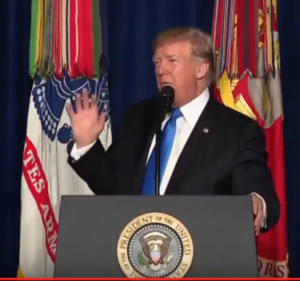By Luciane Noronha M. de Oliveira
The night of August 20 was marked by Donald’s Trump much awaited speech on the USA’s new strategy for America’s longest war. Despite not talking openly about what will change in operational terms, it is important to point out a few strategic features of his plan that might change the dynamics of power balance in South Asia.
First of all, Donald Trump exposed the exhaustive human efforts made in the last 16 years since the war in Afghanistan started. Contradicting his own previous speeches during presidential campaign, Trump said he acknowledged that simply withdrawing troops, like he supported as a candidate, could lead to greater chaos locally and even contribute to increase the activities of groups like the Taliban, al Qaeda and ISIS – which, in turn, would pose a threat to the United Stated and its citizens. According to his words, the lack of extensive presence of American troops in Iraq and the consequent political vacuum left by early withdrawal was one of the reasons for the creation of ISIS and its expansionism in the region.
This argument leads to the conclusion that U.S. troops will stay for as long as it is considered relevant – in other words, the war will continue, though in different terms as the previous governments, especially regarding further increase of the number of troops.
By pointing out an end to this trend, Trump’s speech suggests an attempt to reinforce the strategy of surgical strikes, as shown by recent military operations conducted in which drones were used to hit terrorist camps. Mentioning the 9/11 and the recent attacks in Barcelona, Trump played the “emotional card” to suggest a bolder stance at fighting terrorism without continuing a “nation-building” in Afghanistan. This might be one of the most important factors in his speech, since the U.S has provided billions of dollars in the last decade to rebuild the country and directly interfered in its domestic affairs several times.
Pakistan was also mentioned as a safe haven for terrorists and as a target of the new counterterrorism strategy of the U.S for South Asia. The speech at the White House suggests that financial aids to Islamabad might suffer a cut down, due to the protection given by the government and its intelligence agencies to the Taliban and other terrorist groups that live near the Afghan border.
For years, there has been international criticism on the paradox of developing successive strategies towards solving the Afghan conflict without including Pakistan and the ongoing financial aid provided by the U.S.
Speaking of India as a main partner was another highlight, as the U.S President called out for a more proactive role of New Delhi in the meeting between Donald Trump and Narendra Modi, June this year. By these two aspects, one can identify a convergence of interests between New Delhi and Washington when it comes to Pakistan and its links with terrorism. This is a significant factor which implies that strategic cooperation between India and the United States will still be an important matter for the current American government.
For India, the plan disclosed by U.S President can unfold into an opportunity to boost its regional policy. New Delhi has been reluctant to interfere in Afghan war, though being a supporter of Ashraf Ghani’s regime and the western offensives against Taliban.
Nonetheless, Indian leaders have failed over the time to convince Washington of including Pakistan in its strategy and recognize it as a terrorism-sponsor-State. The shift of Trump towards South Asia with the “new” strategy for Afghanistan and its assertive approach towards Pakistan shows that political gains made in Obama era might be reinforced in a more realistic approach.
Furthermore, the weakening of American nation-building policy in Afghanistan opens a new opportunity for India to project power in a region of interest. The bilateral cooperation between the two countries can be strengthened by New Delhi playing a major role assisting major development programs.
And last but not least, a possible convergence between India and the U.S towards Pakistan represents a regional strategic gain for India. The designation of Syed Saladuddin, chief of the United Jihad Council, as a “global terrorist” by the U.S and its stance on the role of Islamabad in influencing regional conflicts gives a new dimension of legitimacy to New Delhi’s military operations against Pakistan in other fronts, like Kashmir.
Despite not closely related to the Afghan war, India might take it in its advantage against one of its major rivals. New Delhi’s Central Asia reach has been significantly hampered by its litigious relation with Islamabad. Bolstering its cooperation with Afghanistan, on the other hand, can contribute to India’s regional aspirations and ease its access to Central Asian countries.
Despite optimistic views and opportunities, it is also important to keep up with negative consequences of Trump’s Afghan policy for India. A closer partnership between New Delhi and Washington on counterterrorism initiatives can trigger further hostilities between India and Pakistan in the disputed borders, and even entail a greater Chinese interference in Islamabad’s favor, as a counterbalance to American and Indian efforts. China’s foreign minister Wang Yi has already reaffirmed that Beijing stands with Pakistan, only a few hours after Trump’s White House event.
It is not clear yet if President Donald Trump will stick to his words when it comes to dealing with the Afghan war. However, given the facts provided by his speech at the White House and his approach to India so far, it is clearly possible that the new U.S Afghan strategy may represent new significant opportunities for India’s foreign policy and its regional projection.

